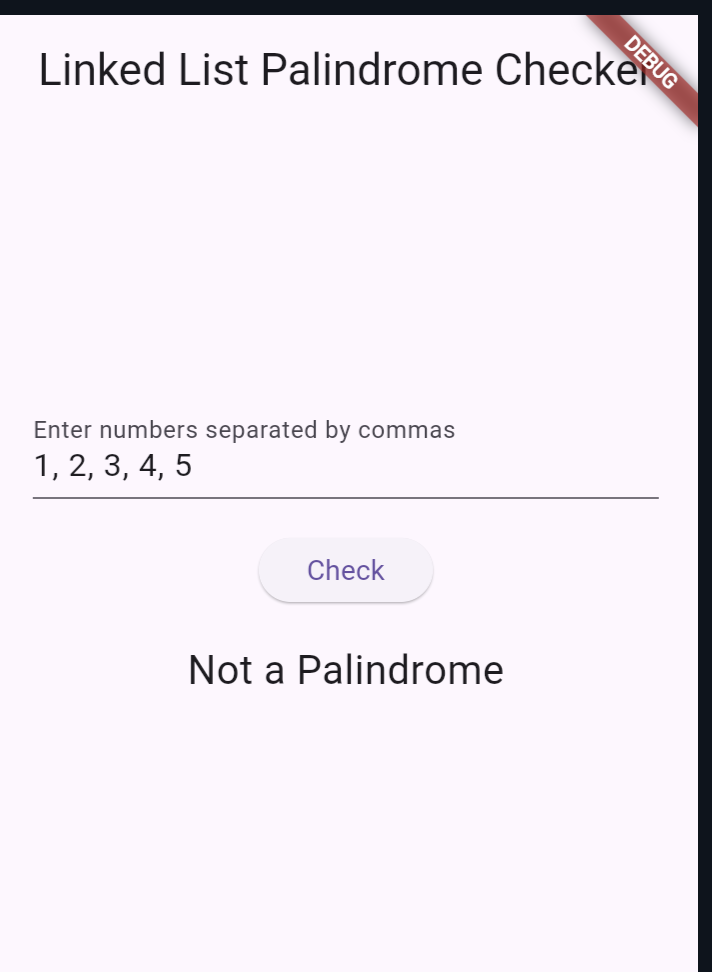In this blog post, we’ll explore how to Check if Linked list is Palindrome in Flutter number using Dart and Flutter. A linked list is a data structure where elements are stored in nodes, and each node points to the next node. A palindrome number is a number that reads the same backward as forward.
Table of Contents

We’ll build a Flutter application to input a sequence of numbers, represent it as a linked list, and check if the sequence forms a palindrome. This exercise will help you understand data structures and algorithms while working with Dart and Flutter.
Why learn to Check if Linked list is Palindrome in Flutter
- Data Structures: Linked lists are fundamental data structures, and understanding them is crucial for solving complex problems.
- Algorithmic Thinking: Checking for palindromes involves algorithmic thinking, including reversing sequences and comparing them.
- Flutter Development: This exercise will enhance your skills in Flutter, particularly in creating interactive UIs and managing state.
The Project – Check if Linked list is Palindrome
First, ensure you have Flutter installed. If not, follow the official Flutter installation guide.
Create a new Flutter project:
flutter create linked_list_palindrome
cd linked_list_palindrome
Replace the contents of lib/main.dart with the following code:
import 'package:flutter/material.dart';
void main() {
runApp(MyApp());
}
class MyApp extends StatelessWidget {
@override
Widget build(BuildContext context) {
return MaterialApp(
title: 'Linked List Palindrome Checker',
home: PalindromeCheckerScreen(),
);
}
}
class Node {
int data;
Node? next;
Node(this.data);
}
class LinkedList {
Node? head;
void append(int data) {
if (head == null) {
head = Node(data);
} else {
Node current = head!;
while (current.next != null) {
current = current.next!;
}
current.next = Node(data);
}
}
bool isPalindrome() {
if (head == null) return true;
Node? slow = head, fast = head;
List<int> stack = [];
while (fast != null && fast.next != null) {
stack.add(slow!.data);
slow = slow.next;
fast = fast.next!.next;
}
if (fast != null) {
slow = slow!.next;
}
while (slow != null) {
int top = stack.removeLast();
if (top != slow.data) {
return false;
}
slow = slow.next;
}
return true;
}
}
class PalindromeCheckerScreen extends StatefulWidget {
@override
_PalindromeCheckerScreenState createState() =>
_PalindromeCheckerScreenState();
}
class _PalindromeCheckerScreenState extends State<PalindromeCheckerScreen> {
final TextEditingController _controller = TextEditingController();
String _result = "";
LinkedList _linkedList = LinkedList();
void _checkPalindrome() {
setState(() {
List<String> inputs = _controller.text.split(',');
_linkedList = LinkedList();
for (var input in inputs) {
_linkedList.append(int.parse(input.trim()));
}
_result = _linkedList.isPalindrome() ? "Palindrome" : "Not a Palindrome";
});
}
@override
Widget build(BuildContext context) {
return Scaffold(
appBar: AppBar(
title: Text('Linked List Palindrome Checker'),
),
body: Padding(
padding: const EdgeInsets.all(20.0),
child: Column(
mainAxisAlignment: MainAxisAlignment.center,
children: [
TextField(
controller: _controller,
decoration: InputDecoration(
labelText: 'Enter numbers separated by commas',
),
keyboardType: TextInputType.number,
),
SizedBox(height: 20),
ElevatedButton(
onPressed: _checkPalindrome,
child: Text('Check'),
),
SizedBox(height: 20),
Text(
_result,
style: TextStyle(fontSize: 20),
),
],
),
),
);
}
}
- Node Class: Represents each node in the linked list, containing data and a pointer to the next node.
- LinkedList Class: Manages the linked list, with methods to append data and check if the list is a palindrome. The
isPalindromemethod uses a stack to compare the first half of the list with the reversed second half.
PalindromeCheckerScreen Stateful Widget
class PalindromeCheckerScreen extends StatefulWidget {
@override
_PalindromeCheckerScreenState createState() =>
_PalindromeCheckerScreenState();
}
class _PalindromeCheckerScreenState extends State<PalindromeCheckerScreen> {
final TextEditingController _controller = TextEditingController();
String _result = "";
LinkedList _linkedList = LinkedList();
void _checkPalindrome() {
setState(() {
List<String> inputs = _controller.text.split(',');
_linkedList = LinkedList();
for (var input in inputs) {
_linkedList.append(int.parse(input.trim()));
}
_result = _linkedList.isPalindrome() ? "Palindrome" : "Not a Palindrome";
});
}
@override
Widget build(BuildContext context) {
return Scaffold(
appBar: AppBar(
title: Text('Linked List Palindrome Checker'),
),
body: Padding(
padding: const EdgeInsets.all(20.0),
child: Column(
mainAxisAlignment: MainAxisAlignment.center,
children: [
TextField(
controller: _controller,
decoration: InputDecoration(
labelText: 'Enter numbers separated by commas',
),
keyboardType: TextInputType.number,
),
SizedBox(height: 20),
ElevatedButton(
onPressed: _checkPalindrome,
child: Text('Check'),
),
SizedBox(height: 20),
Text(
_result,
style: TextStyle(fontSize: 20),
),
],
),
),
);
}
}
- TextEditingController: Manages the text input by the user.
- _checkPalindrome Function: Splits the input string by commas, converts each part to an integer, appends it to the linked list, and sets the result based on whether the list is a palindrome.
- build Method: Builds the UI with a
Scaffoldcontaining anAppBar, aTextFieldfor input, a button to check the palindrome, and aTextwidget to display the result.
Running the App
To run the app, use the following command:
flutter run
This will launch the Linked List Palindrome Checker app on your connected device or emulator.
Also Read:
Output:

Checking if a linked list is a palindrome in Flutter and Dart is a great way to deepen your understanding of data structures, algorithms, and Flutter development.
